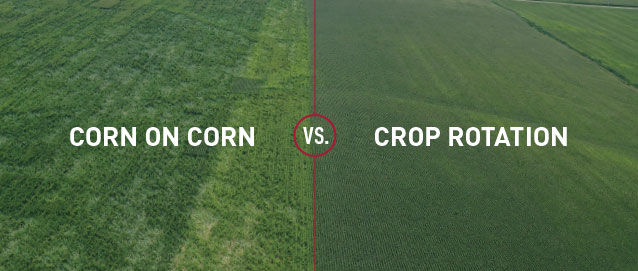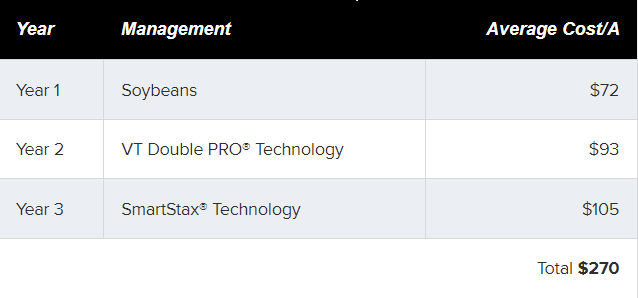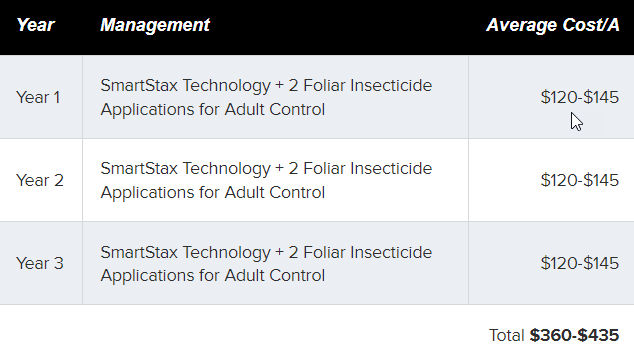Corn on Corn Crop Rotation | Bayer Traits
May 27, 2023
Three favorable aspects of rotating away from corn on corn
Many farmers grow corn on corn in their operation for economic reasons, but there are valuable benefits that come with rotating your crops every five years. Here are the top three reasons why rotating your crops is advantageous.
1. IT HELPS WITH PEST MANAGEMENT.
Choosing to rotate helps with insect and weed management as well as corn rootworm management in the Midwest. Because of corn rootworm, farmers pay more than $1 billion annually in crop damage and increased control costs.* This notorious “billion-dollar bug” can be devastating, especially for fields that have been corn on corn for many years. Rotating to non-host crops can help drive corn rootworm pressure down to reduce corn rootworm feeding and standability losses while also mitigating resistance to traits and insecticides.
2. IT CREATES AN OPPORTUNITY FOR INPUT SAVINGS.
Rotating away from corn on corn helps save on inputs. This is key because nitrogen costs, biotech trait costs, insecticide costs, tillage and more can add up quickly when trying to maximize yield potential. Rotating to crops like soybeans can help lower overall input costs and potentially increase profitability.
3. IT OFFERS GREATER ROI AND YIELD POTENTIAL.
When growing corn on corn, there can be the potential for a yield hit or drag. By rotating to soybeans, you may see positive soil benefits through residue management, water management and increased nutrient availability. A reduction in diseases can also occur because the pathogens don’t have a chance to live in the residue awaiting the following season. When you look at the combined benefits of crop rotation, you can see the possibility of a higher yield and profit potential.

FIELD NOTES FROM NICOLE STECKLEIN
Bayer Technical Agronomist in Eastern Iowa
“I'm a technical agronomist in eastern Iowa. In my part of the world, we have hills and a lot of livestock, so there's a lot of corn on corn in our area. For the last couple of years, this 30-acre plot we have hasn't been living up to its potential. I did a little digging and discovered that we were losing standability and quite a bit of yield to rootworm feeding. As much as you don't like to put your best 30 acres into soybeans, we felt like that was our best option because our number one issue is just that we have too many corn rootworms after years of corn on corn.
We didn't expect that we would have the bean yield that we did with over 90 bushels an acre on 30 acres. By giving that field a break from corn, it's going to help us with our residue management. It's going to make the seed costs lower because we can put a VT Double PRO® RIB Complete® product in that field so we don't have to pay for the extra traits. It's giving us a break as far as tillage goes, so now we can save costs on tillage."
“We're happy with the benefits that we got this year, but we're also looking forward to the potential economic and agronomic benefits for next year.”
EXPLORE THE SHORT- AND LONG-TERM BENEFITS OF ROTATION
This calculator is a helpful tool when projecting potential costs. The costs below are estimates based on available third-party data and internal estimates and are for demonstration purposes only. Other variables like additional input costs, operational expenses or other discounts could affect the cost outcome in ways not shown below.
___
Scenario 1: ROTATE TO SOYBEANS

Outcome:
👍 Corn rootworm pressure reduced
👍 Minimized issues of standability and yield loss
👍 Least risk to trait longevity
_____
Scenario 2: VT DOUBLE PRO TECHNOLOGY + IN-FURROW INSECTICIDE + FOLIAR INSECTICIDE

Outcome:
👍 Corn rootworm populations decrease but at a slower rate than by rotating to soybeans
👎 Increased potential for standability issues and yield loss in the first year with less risk in years two and three
👎 More risk to trait longevity
_____
Scenario 3: SMARTSTAX TECHNOLOGY + FOLIAR INSECTICIDE

Outcome:
👍 Corn rootworm populations decrease but at a slower rate than by rotating to soybeans
👎Increased potential for standability issues and yield loss in the first year with less risk in years two and three
👎 More risk to trait longevity
No results are guaranteed, and Bayer and its affiliates hereby disclaim any liability related, directly or indirectly, to the application, or accuracy, of the results provided by this calculator.
IT’S IMPORTANT TO DO WHAT’S BEST FOR YOUR OPERATION.
To start your calculations, your local Bayer representative is a great resource and can offer valuable support.
Contact your local Bayer representative to learn more about the value of rotation.